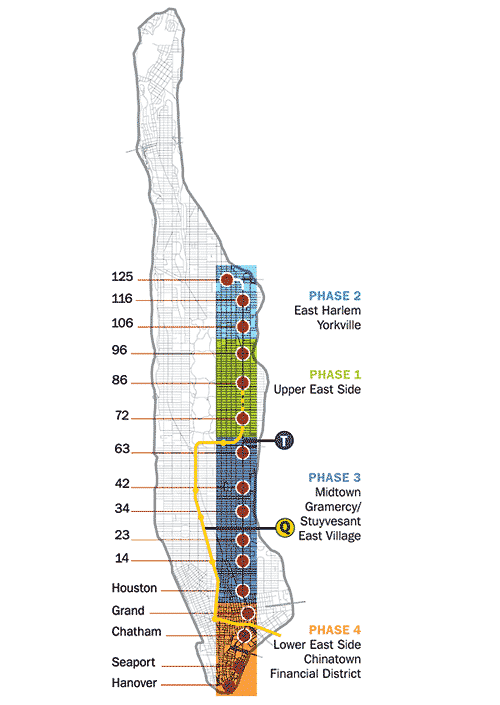Miracle on (and Under) Second Avenue
Learning Objectives:
- Discuss the history of the Second Avenue Subway project.
- Explain the excavation methods that will be used to create the subway's tunnels.
- Discuss the project's noise- and vibration-mitigation features.
Credits:
With derisive taglines like "the most famous thing that's never been built" and "the line time forgot," news this spring that New York City's Second Avenue Subway (SAS) was about to start construction was met with nearly unanimous approval tempered by cautious optimism, despite the guarantee of years of unceasing construction affecting hundreds of thousands of Manhattan residents, institutions, and businesses. Public consensus acknowledged that the long-term advantages outweigh the short-term disruptions and inconveniences.
Predicted to cost $16.8 billion (in 2004 dollars), the mega-infrastructure project is the largest public-works undertaking in New York in 50 years. To be built in four phases, over an estimated 16 years, the new subway-also known as the T Line-will serve approximately 500,000 riders daily at 16 new stations along 8.5 miles of new track. It will relieve the overburdened Lexington Avenue Line, the only subway serving the East Side, which reportedly operates at 120 percent capacity.
Almost from the moment of conception in 1929, the project became the perennial victim of every 20th-century economic crisis and vagary of war. During the Great Depression, the project was scaled back and then postponed indefinitely in 1939. A new master plan was considered, then suspended in 1941 along with other nonessential public works, when the U.S. entered World War II. Another postwar scheme was shelved due to huge inflation experienced during the Korean War. Multiple iterations later, construction began in 1972, only to be abruptly halted as New York City teetered on the brink of bankruptcy.
Another 20 years went by, and finally the Metropolitan Transit Authority (MTA) and New York City Transit (NYCT) began the Manhattan East Side Alternatives Study. The goal was to recommend a course of action to reduce crowding and delays on the Lexington Avenue Line and create mass-transit accessibility for the far East Side of Manhattan. The study team compiled a list of more than 20 alternatives to resolve existing and future transportation issues, including the resurrection of the master plan for a new Second Avenue Subway.
|
|
In July 2004, the Federal Transit Administration (FTA) certified that the requirements of the National Environmental Policy Act had been satisfied for the Second Avenue Subway project. By December, preliminary engineering was completed for all four phases. Two years later, in April 2006, Extended and Final Preliminary Engineering was done. The FTA then authorized the MTA to begin the Final Design of Phase I. On April 12, 2007, the governor, other state and city officials, and several transit administrators broke ground for the fourth time since 1929 and declared the project under way. And they mean it this time.
It takes a big village to build a subway
Public infrastructure projects are by definition enormously complex undertakings, involving dozens of local, state, and federal agencies; community boards; arts commissions; and teams of architecture, engineering and construction consultants. Officially, the MTA and the NYCT are the clients. In that role, the MTA assembled a team to plan, design and engineer, schedule, and oversee construction of the phased project. This team, a DMJM Harris/Arup joint venture, is a complex, expansive architecture and engineering partnership. The principal players of the joint venture, representing all the design and engineering specialties, work under one roof under the authority of the NYCT's Second Avenue Subway Project, an entity of the MTA Capital Construction Company.
"There are many stakeholders involved in every phase of planning and design," says Anil Parikh, SAS program manager. "We conduct working groups with technical advisers, the design team, and user representatives to discuss constructibility, operations, and maintenance, and then investigate options, debating the pros and cons of each," he explains.










